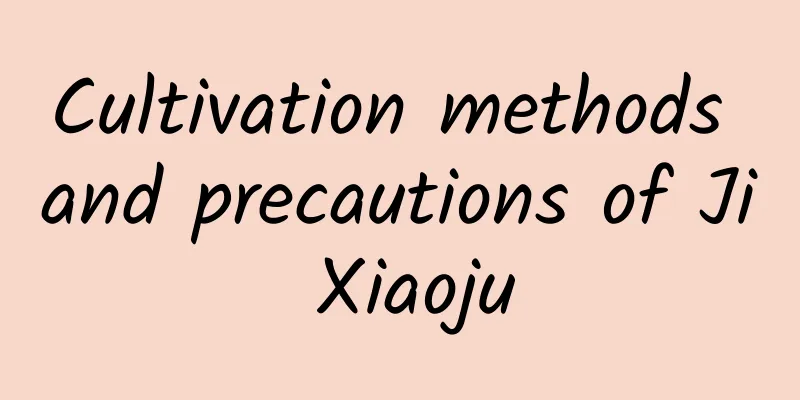Cultivation methods and precautions of Ji Xiaoju

|
Chrysanthemum is very easy to grow, and its flowering period is long. It blooms many beautiful flowers. Keeping a few pots at home has great ornamental value. When it blooms, the branches are full of flowers, which are brilliant like brocade, fresh and elegant, full of charm. It rarely gets insects and diseases, and management is relatively extensive. It is an easy-to-grow and very flowering plant. How to cultivate Ji XiaojuThe biggest advantage of the daisy is its strong adaptability. Precisely because of its strong adaptability, it does not have high requirements for soil. Ordinary soil will do. Place it in a sunny place and keep the soil moist. During the growth period of the daisy, it should be continuously fertilized. Generally speaking, liquid fertilizer can be added once every ten days or so. 1. Lighting: Chrysanthemum is naturally light-loving and needs sufficient sunlight to complete photosynthesis and respiration, thereby promoting the germination of branches and buds, so that more side buds can differentiate into flower buds. 2. Temperature: The optimum growth temperature for daisy is generally between 15 and 22 degrees Celsius. If you want to spend the winter safely, the room temperature cannot be lower than 5 degrees Celsius, otherwise the plant will be frostbitten. In severe cases, it will be directly frozen to death, so protective measures such as keeping warm and cooling down should be taken. 3. Watering: When watering the chrysanthemum on a daily basis, in addition to strictly adhering to the principle of watering when the soil is dry and watering thoroughly, you should also learn to accurately judge the best time to water the flowers. You can weigh the flowerpot with your hand. If it becomes obviously lighter, you need to water it as soon as possible. Otherwise, you can wait for a few more days. 4. Fertilization: Chrysanthemum is relatively fond of fertilizer. As for the flower fertilizer suitable for daily use, according to the different stages of the plant, you should usually use a compound fertilizer that is rich and balanced in three elements and a phosphorus and potassium fertilizer with a first-class flowering-promoting effect. 5. Pruning: For this plant, regular topping can effectively prevent the plant from growing too tall, help shape it, improve the appearance of the daisy, and reduce unnecessary consumption of nutrients, applying them fully where they are needed. Precautions for the maintenance of Ji XiaojuWhen caring for chrysanthemums, you should pay attention to topping the seedlings. Topping can promote branching and make the plant fuller. After the flower buds appear, apply more phosphorus and potassium fertilizers to make the flowers more colorful. Also, provide sufficient light. If there is insufficient light, the flower color will fade. After the flowers are fully bloomed, prune them in time to control the plant shape. |
<<: Breeding methods and precautions of Golden Diamond Green Princess
>>: What season is suitable for planting bitter chrysanthemum
Recommend
Cultivation methods and precautions of creeper, what to do if you apply too much fertilizer
1. Breeding methods 1. Light: Ivy has strong vita...
The difference between Lucong and Bana
1. Leaf Difference The leaves of the deer onion a...
Does peony prefer shade or sun?
Does peony prefer shade or sun? Peonies are very ...
When does clematis bloom?
1. Flowering time There are early-flowering and l...
How to change the soil and pot of potted lemon
Time to repot potted lemons The best time to repo...
Why do the leaves of the ball orchid turn yellow?
1. Too much light Reason: It is a relatively ligh...
Summer maintenance of plum bonsai
Proper Placement Plum blossom is a native tree sp...
How to grow Camptotheca acuminata
1. Soil: Camptotheca acuminata grows faster when ...
What kind of flower pot looks good for Lingzhi
What flower pots look good with Lingzhi Ganoderma...
Can peonies be planted in pots?
Can peonies be planted in flower pots? Peonies ca...
How to raise Ansno
1. Breeding environment Soil: When growing Ansno,...
How often should you water your apple tree? What is the best time and method to water your apple tree?
Apple trees are very water-loving fruit trees, so...
How to root Clivia without roots in hydroponics
1. Drying method Choose a Clivia without roots an...
How to eat Artemisia serrata
The correct way to eat Artemisia selengensis Matu...
Don't throw away the "waste oil" from the range hood. Use it as fertilizer for flowers to grow more and more
Growing flowers has now become a national hobby. ...









